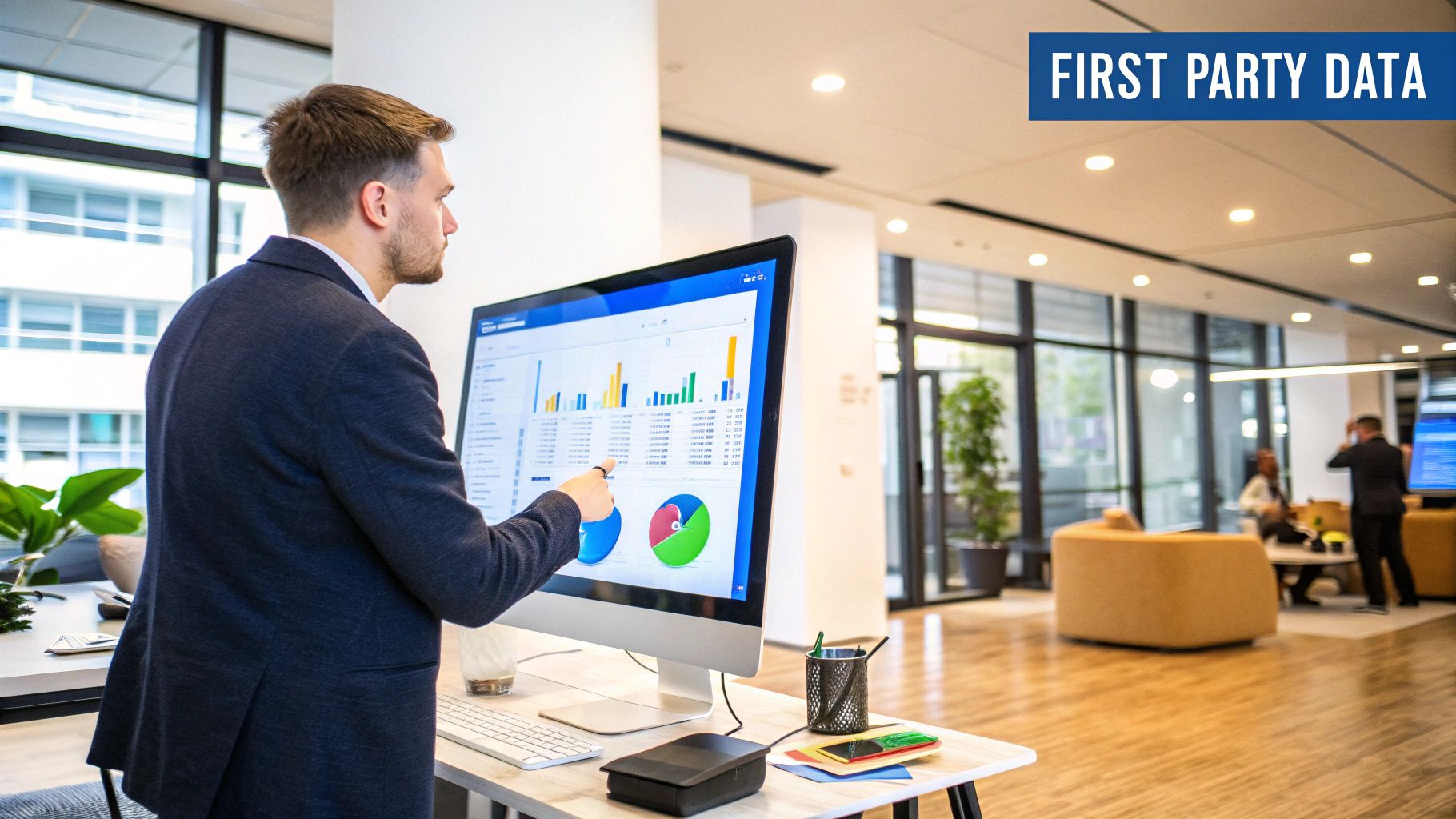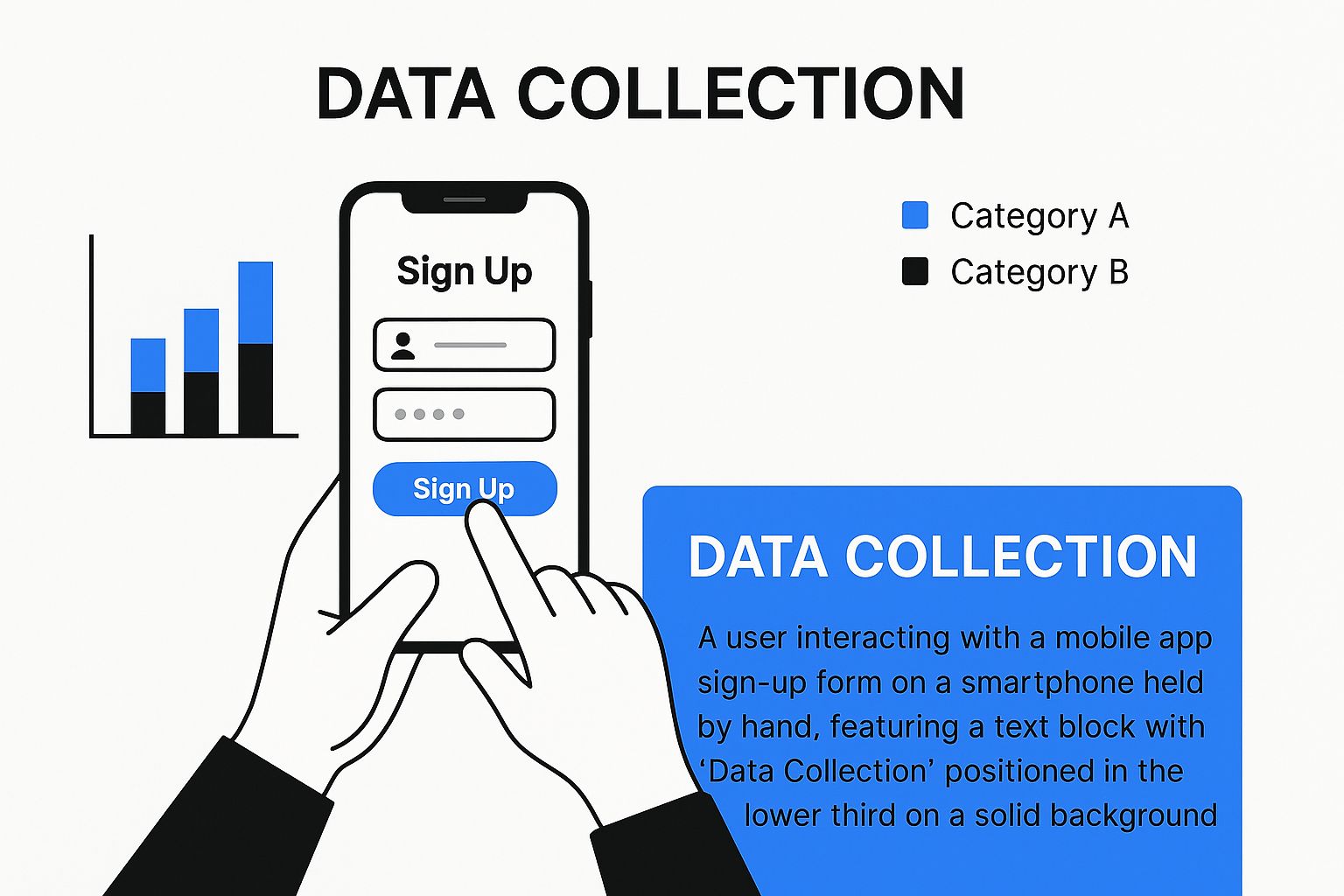Let’s cut through the jargon. Think about the difference between a heartfelt conversation you have with a customer versus a third-hand rumor you heard about them. That’s the core difference between first-party data and everything else. In short, first-party data is the information your customers willingly and directly share with your brand, which you then own and control.

For years, marketers leaned heavily on third-party data—information scraped and sold by external companies to anyone willing to pay. It offered scale, but the accuracy and consent were always questionable. Now, that entire approach is becoming obsolete. The marketing world is going through a massive shift, driven by two key forces: a growing demand for consumer privacy and the technical end of third-party cookies in major browsers.
This new reality makes first-party data not just a "nice-to-have," but the absolute foundation of modern, effective marketing. It's the most reliable, accurate, and ethically sound information you can get because it comes straight from the source: your customers.
This isn’t some abstract concept; it’s the trail of digital breadcrumbs your audience leaves behind every time they interact with your brand. This valuable data includes:
The primary benefit of first-party data is that your audience shares this information directly with you. You have no concerns about permission, as people agree to receive communications from you straight away.
The real value here goes way beyond just having a contact list. First-party data gives you a crystal-clear window into your customers' genuine interests and intent. Because you collect it yourself, you have total transparency into where it came from and how accurate it is. That direct relationship is everything when it comes to building trust.
Unlike third-party data, which is often a black box of uncertainty, you own your first-party data outright. It’s a unique, proprietary asset that your competitors simply can’t buy or replicate. This ownership is critical in a world with tightening data regulations and increasing risks from relying on outside providers.
While it’s helpful to get into the weeds of how cookies work, the bigger picture is about data ownership. If you'd like a deeper dive, you can explore the key differences between first-party vs. third-party cookies in our detailed guide.
Ultimately, this data is what allows you to stop shouting at the crowd with generic marketing blasts and start having meaningful, personalized conversations that drive real business results—from higher engagement and conversion rates to lasting customer loyalty.
The sudden, intense focus on first-party data isn't happening in a vacuum. It’s the direct result of a perfect storm of tech and regulatory shifts that are completely rewriting the rules of digital marketing. Three powerful forces are converging, making the pivot to your own, consented data an urgent necessity for survival and growth.
Once you understand these drivers, it becomes crystal clear why yesterday’s data strategies are failing and why building your own first-party data assets is the only reliable path forward. Each force is significant on its own; together, they represent a fundamental change in how brands must connect with customers.
For decades, the third-party cookie was the engine of digital advertising. It was a tiny piece of code that allowed advertisers to track users across different websites, building detailed profiles to serve targeted ads. Now, that engine is shutting down for good.
Major web browsers like Google Chrome are phasing out support for these cookies, a move marketers have dubbed the "cookiepocalypse." This change directly breaks the core mechanics of common advertising tactics like retargeting anonymous visitors and tracking conversions across multiple domains.
Without third-party cookies, the ability to follow a user's journey across the web simply vanishes, leaving a massive data gap for marketers who relied on it. This makes your own first-party data, collected directly on your properties, infinitely more valuable. It becomes the only reliable way to understand customer actions. If you're looking for more clarity, our guide on the importance of attribution models in marketing breaks down why accurate tracking is so crucial.
The second major force is a global wave of legislation designed to give consumers more control over their personal information. This isn't just a passing trend—it's a legal requirement with serious financial penalties for non-compliance.
You’ve almost certainly heard of regulations like:
These laws fundamentally alter the data landscape. They require businesses to be completely transparent about what data they collect and how they use it, mandating explicit consent from users. This makes ethically sourced first-party data non-negotiable for avoiding steep fines and legal risks. Relying on third-party data with questionable consent origins is now a dangerous gamble.
The core principle is simple: consumers now have the legal right to control their data. This shift inherently favors first-party data, as it is collected with direct and transparent consent from the user, building trust rather than risking it.
The third force is the rapid advancement of artificial intelligence and large language models (LLMs). These tools offer incredible potential for personalization, predictive analytics, and optimizing marketing campaigns. However, they all share one critical weakness: they need clean, high-quality data to function effectively.
It’s the classic "garbage in, garbage out" problem. If you feed an AI model with inaccurate, incomplete, or biased third-party data, it will spit out flawed insights and poor recommendations. The importance of first-party data has shot up as businesses realize that high-quality, fully permissioned information is the only way to get accurate, unbiased insights from AI. You can discover more about how AI is increasing the importance of first-party data in 2025 and its impact on personalization.
Think of first-party data as the premium fuel for these advanced systems. It provides the context-rich, consented information needed to power truly intelligent marketing and drive decisions you can actually trust.
Collecting high-quality first-party data isn't about tricking people; it's about creating a clear and valuable exchange. The best strategies are transparent, offering genuine benefits that make customers want to share their information. To build a rich data foundation, you have to move beyond a simple "Contact Us" form.
The core principle is simple: provide value first. Whether that’s exclusive content, a better user experience, or personalized recommendations, the incentive has to be compelling. This approach builds trust from the very first interaction and sets the stage for a lasting customer relationship.
The image below shows how even a simple mobile sign-up process is a powerful moment for data collection, kicking off the customer relationship on the right foot.

This visual highlights a key point: basic interactions like an app registration are fundamental opportunities to gather consented, high-value data directly from the user.
While website and checkout forms are essential, you can gather much richer data by thinking more creatively. The goal is to create interactive and rewarding experiences that don't feel like a chore.
Here are several proven methods for collecting first-party data:
These tactics work because they feel less like a transaction and more like a helpful exchange. The user gets something tangible, and you get accurate, relevant data. To dive deeper into acquiring valuable customer information, you can explore lead generation best practices and apply those frameworks to your data collection efforts.
The most effective first-party data strategies feel like a natural conversation. You ask for information by offering something useful in return, which builds trust and encourages customers to share more over time.
To help you choose the right approach, here’s a quick comparison of different collection methods.
Collection MethodData Type CollectedUser IncentivePrimary Use CaseLead MagnetsEmail, Name, Company, RoleExclusive ContentLead Generation & NurturingInteractive QuizzesPreferences, Pain Points, NeedsPersonalized ResultsAudience SegmentationLoyalty ProgramsPurchase History, Frequency, LTVDiscounts & RewardsCustomer RetentionAccount CreationDemographics, Contact InfoBetter User ExperiencePersonalization & ServiceSurveys & FeedbackSatisfaction, Product OpinionsChance to Win, Feeling HeardProduct & CX Improvement
Each method offers a unique window into your customer's world. The key is to match the method to your business goal, whether that's generating new leads, retaining existing customers, or just understanding your audience better.
Your data collection shouldn't be limited to just your marketing campaigns. Every single touchpoint across the customer journey is a chance to learn more and refine your understanding.
Think about these often-overlooked channels:
This comprehensive approach ensures you're building a holistic, 360-degree view of your customer. Every piece of data you collect helps you serve them better, creating a virtuous cycle of personalization and loyalty.
Plus, accurate collection across all these sources is fundamental for your advertising. If you're running paid campaigns, understanding https://www.cometly.com/post/why-do-you-need-ad-tracking-management-software is crucial for connecting your collected data to actual ad performance. By unifying data from every source—from a lead magnet to a final purchase—you can see exactly which efforts are driving revenue.
Collecting high-quality first-party data is a huge first step, but it’s only half the battle. Raw data sitting in different systems is like having a pantry full of amazing ingredients but no kitchen to cook in. Your website analytics know what a customer browsed, your CRM knows their support history, and your e-commerce platform knows what they bought. The real challenge is bringing it all together to create something useful.
This is where a Customer Data Platform (CDP) becomes the central nervous system for your entire data strategy. Think of a CDP as a smart hub that connects all your data sources—from your website and app to your CRM and even offline store data—and merges them into a single, unified profile for each and every customer. It’s the tool that finally breaks down the walls between departments and technologies.
Without a CDP, your customer data lives in isolated "silos." Marketing has its data, sales has its own, and customer service operates from yet another system. This fragmentation makes it impossible to see the complete picture of a customer's journey and interactions with your brand.
A CDP solves this problem by ingesting data from every touchpoint and stitching it all together. The result is a unified customer profile—a 360-degree view that combines every action, preference, and transaction tied to a single individual. This complete view is the key to unlocking sophisticated marketing and personalization at scale. To get the most out of your CDP, it's crucial to follow strong data integration best practices to ensure everything flows together correctly.
A unified profile means you no longer see "User #12345" who browsed a product and "Jane Doe" who contacted support as two different people. You see one customer, Jane Doe, whose complete history informs how you interact with her next.
Once your data is unified, a CDP lets you "activate" it across all your marketing, sales, and service channels. Activation is the process of turning insights from your first-party data into real, tangible actions. This is where you move from just knowing your customers to actively personalizing their experience.
Here’s how a CDP helps you activate your data:
The investment in platforms that enable this kind of activation is skyrocketing. The global Customer Data Platform market was recently valued at around $2.4 billion and is projected to grow significantly by 2030. This boom is driven by the urgent need for privacy-friendly data solutions and the massive demand for AI-powered personalization.
A CDP isn't just another database; it’s an engine for action. It transforms your first-party data from a passive asset into the active fuel for your entire growth strategy, turning scattered information into coherent customer experiences and real business intelligence.

Alright, so you’ve collected and organized your customer information. Now what? This is where the real work begins—and where your investment in first-party data starts paying dividends. It’s the difference between having a map and actually arriving at your destination.
With a clean, consolidated view of your customers, you can finally move beyond generic, one-size-fits-all marketing. This data is the key to creating relevance at every single touchpoint, from the first ad a user sees all the way to the post-purchase follow-up.
Let’s be honest: personalization isn't just about using a customer's first name in an email anymore. Real personalization is about anticipating what someone needs before they even ask, all based on their past behavior. First-party data makes this possible by giving you a detailed history of every interaction.
Imagine a customer visits your e-commerce store and spends a few minutes browsing a specific category of products, like running shoes. With first-party data, you can dynamically change your homepage on their next visit to feature those very products. It creates a tailored shopping experience that feels intuitive and helpful, which dramatically increases the odds of a conversion.
This is especially powerful in email marketing. By using customer data to drive email marketing success, you can segment your lists based on purchase history or browsing behavior. Instead of a generic newsletter blast, you send targeted campaigns that actually resonate.
A study by Google and Boston Consulting Group found that businesses using first-party data for key marketing functions achieved up to a 2.9x revenue uplift and a 1.5x increase in cost savings. This isn't just a small bump; it's a direct financial impact that comes from moving from broad assumptions to data-driven actions.
One of the most impactful ways to use first-party data is in paid advertising. Platforms like Google and Meta have a game-changing feature that lets you upload a list of your best customers—think people with the highest lifetime value or purchase frequency—and then build a lookalike audience.
You’re essentially telling the ad platform, "Go find me more people exactly like these." The algorithm then gets to work, identifying new users who share characteristics and behaviors with your existing top-tier customers. This is infinitely more effective than targeting based on broad, generic interests alone.
This strategy completely transforms your return on ad spend (ROAS) because you’re no longer guessing who your ideal customer is. You're using your own proven data to find them, ensuring your ad budget is spent reaching people who are most likely to convert.
We all know it’s way more expensive to acquire a new customer than to keep an existing one. First-party data is your secret weapon for fostering loyalty because it allows you to be proactive and personal, making customers feel seen and valued.
Consider these practical ways to boost retention:
By understanding the complete customer journey, you can anticipate needs and solve problems before they even pop up. If you want to dig deeper into mapping these interactions, our article on how customer journey software helps businesses scale offers some great insights. This kind of proactive approach is what turns one-time transactions into lasting relationships, forging stronger bonds in an increasingly competitive world.
As marketers and business owners start moving toward a privacy-first world, a lot of practical questions come up. Making the switch away from third-party data can feel like a huge task, but once you understand a few key concepts, you can move forward with confidence.
Let's break down some of the most common questions to help you navigate this new terrain.
The easiest way to think about this is "observation vs. conversation."
First-party data is what you gather by observing a user's behavior. Think about the pages they visit on your site, the products they add to their cart, or how often they buy from you. You're collecting this information implicitly based on their actions on your properties.
Zero-party data, on the other hand, is information a customer intentionally and proactively tells you about themselves. It's explicitly shared. This could be their preferences from a quiz, their goals from a welcome survey, or their communication choices in a preference center.
A simple analogy: First-party data is like a shopkeeper noticing a customer spends most of their time in the coffee aisle. Zero-party data is that same customer walking up and saying, "Just so you know, I only drink dark roast." Both are valuable, but zero-party data gives you crystal-clear intent, no guesswork required.
Ultimately, zero-party data is an incredibly valuable subset of first-party data. It comes straight from the source and tells you exactly what your customers want.
Yes, but its role has changed dramatically, and its usefulness for one-to-one marketing is disappearing fast. The big shake-up is the phase-out of third-party cookies, which were the main way marketers tracked individual users across different websites for ad targeting. To get a clearer picture of this shift, you can read our guide on saying goodbye to third-party cookies.
This means third-party data is no longer a reliable tool for individual retargeting or building granular user profiles. Its modern role is pretty much limited to providing broad, aggregated market research or general audience trends. For instance, you might look at a third-party report to understand demographic trends in a new region you're expanding into.
From now on, your strategy has to be built on a solid foundation of first-party data. Think of third-party data as a secondary, supplementary source for high-level market intelligence—not for individual customer interactions.
Good news: you don't need a massive, enterprise-level software suite to start building your first-party data assets. Many of the most powerful and effective methods are completely free or very low-cost, making them perfect for small businesses.
The key is to open a direct line of communication and offer a clear value exchange. It's not about the budget; it's about the relationship. Here are a few practical ways to get started:
The goal is to start a conversation and build trust. Every email address you collect or survey response you receive is another valuable piece of first-party data that you own—and can use to better serve your audience.
Ready to turn your hard-earned first-party data into measurable growth? Cometly unifies your data from every channel, providing crystal-clear attribution so you can see exactly which marketing efforts are driving revenue. Stop guessing and start optimizing with confidence. See how Cometly can transform your marketing ROI.
Learn how Cometly can help you pinpoint channels driving revenue.
.svg)
Network with the top performance marketers in the industry